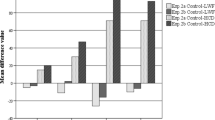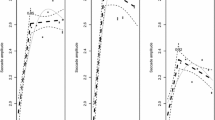Abstract
Introduction
Cannabis is known to produce substantial acute effects on human cognition and visuomotor skills. Many recent studies additionally revealed rather long-lasting effects on basic oculomotor control, especially after chronic use. However, it is still unknown to what extent these deficits play a role in everyday tasks that strongly rely on an efficient saccade system, such as reading.
Materials and methods
In the present study, eye movements during sentence reading of 20 healthy long-term cannabis users (without acute tetrahydrocannabinol-intoxication) and 20 control participants were compared. Analyses focused on both spatial and temporal parameters of oculomotor control during reading.
Results
Long-term cannabis users exhibited increased fixation durations, more revisiting of previously inspected text, and a substantial prolongation of word viewing times, which were highly inflated for longer and less frequent words.
Discussion
The results indicate that relatively subtle performance deficits on the level of basic oculomotor control scale up as task complexity and cognitive demands increase.

Similar content being viewed by others
References
CELEX German Database (1995) Release D25. Computer software. Centre for Lexical Information, Nijmegen
Clifton C, Staub A, Rayner K (2007) Eye movements in reading words and sentences. In: Van Gompel R, Fischer M, Murray W, Hill R (eds) Eye movement research: a window on mind and brain. Elsevier, Oxford, pp 341–372
Croft RJ, Mackay AJ, Mills ATD, Gruzelier JGH (2001) The relative contributions of ecstasy and cannabis to cognitive impairment. Psychopharmacology 153:373–379
Ehrenreich H, Rinn T, Kunert HJ, Moeller MR, Poser W, Schilling L, Gigerenzer G, Hoehe MR (1999) Specific attentional dysfunction in adults following early start of cannabis use. Psychopharmacology 142:295–301
Ettinger U, Williams SCR, Patel D, Michel TM, Nwaigwe A, Caceres A, Mehta MA, Anilkumar AP, Kumari V (2009) Effects of acute nicotine on brain function in healthy smokers and non-smokers: estimation of inter-individual response heterogeneity. Neuroimage 45:549–561
Findlay JM, Walker R (1999) A model of saccade generation based on parallel processing and competitive inhibition. Behav Brain Sci 22:661–674
Fletcher JM, Page JB, Francis DJ, Copeland K, Naus MJ, Davis CM, Morris R, Krauskopf D, Satz P (1996) Cognitive correlates of long-term cannabis use in Costa Rican men. Arch Gen Psychiatry 53:1051–1057
Glass M, Dragunow M, Faull RLM (1997) Cannabinoid receptors in the human brain: a detailed anatomical and quantitative autoradiographic study in fetal neonatal and adult human brain. Neuroscience 27:299–318
Gonzalez R, Carey C, Grant I (2002) Nonacute (residual) neuropsychological effects of cannabis use: a qualitative analysis and systematic review. J Clin Pharmacol 42:48–57
Herkenham M, Lynn AB, Little MD, Johnson MR, Melvin LS, de Costa BR, Rice KC (1990) Cannabinoid receptor localization in the brain. Proc Natl Acad Sci USA 87:1932–1936
Huestegge L, Radach R, Kunert HJ, Heller D (2002) Visual search in long-term cannabis users with early age of onset. Prog Brain Res 140:377–394
Huestegge L, Radach R, Kunert HJ (2009a) Long-term effects of cannabis on oculomotor function in humans. J Psychopharmacol 23:714–722
Huestegge L, Radach R, Corbic D, Huestegge SM (2009b) Oculomotor and linguistic determinants of reading development: a longitudinal study. Vis Res 49:2948–2959
Huestegge L, Skottke EM, Anders S, Debus G, Müsseler J (2010) The development of hazard perception: dissociation of visual orientation and hazard processing. Transp Res Part F 13:1–8
Inhoff AW, Radach R, Eiter BM, Juhasz B (2003) Distinct subsystems for the parafoveal processing of spatial and linguistic processing information during eye fixations in reading. Q J Exp Psychol Hum Exp Psychol 56:803–827
Irwing P, Lynn R (2005) Sex differences in means and variability on the progressive matrices in university students: a meta-analysis. Br J Psychol 96:505–524
Iversen LL (2000) The science of marijuana. Oxford University Press, Oxford
Kennedy A, Radach R, Heller D, Pynte J (2000) Reading as a perceptual process. Elsevier, Oxford
Lamers CT, Bechara A, Rizzo M, Ramaekers JG (2006) Cognitive function and mood in MDMA/THC users, THC users and non-drug using controls. J Psychopharmacol 20:302–311
Moeller MR, Doerr G, Warth S (1992) Simultaneous quantitation of delta-9-tetrahydrocannabinol (THC) and 11-nor-9-carboxy-delta-9-tetrahydrocannabinol (THC-COOH) in serum by GC/MS using deuterated internal standards and its application to a smoking study and forensic cases. J Forensic Sci 37:969–983
Ploner CJ, Tschirch A, Ostendorf F, Dick S, Gaymard BM, Rivaud-Pechoux S, Sporkert F, Pragst F, Stadelmann AM (2002) Oculomotor effects of delta-9-tetrahydrocannabinol in humans: implications for the functional neuroanatomy of the brain cannabinoid system. Cereb Cortex 12:1016–1023
Pope HG, Yurgelun-Todd D (1996) The residual cognitive effects of heavy marijuana use in college students. JAMA 275:521–527
Pope HG, Gruber AJ, Yurgelun-Todd D (1995) The residual neuropsychological effects of cannabis. Drug Alcohol Depend 38:25–34
Powell JH, Pickering AD, Dawkins L, West R, Powell JF (2004) Cognitive and psychological correlates of smoking abstinence, and predictors of successful cessation. Addict Behav 29:1407–1426
Radach R, Kennedy A (2004) Theoretical perspectives on eye movements in reading: past controversies, current deficits and an agenda for future research. Eur J Cogn Psychol 16:3–26
Radach R, Rayner K, Kennedy A (2004) Eye movements and information processing during reading. Taylor & Francis, New York
Radach R, Huestegge L, Reilly R (2008) The role of global top-down factors in local eye-movement control in reading. Psychol Res 72:675–688
Rayner K (1998) Eye movements in reading and information processing: 20 years of research. Psychol Bull 124:372–422
Rayner K, Duffy SA (1986) Lexical complexity and fixation times in reading: Effects of word frequency, verb complexity and lexical ambiguity. Mem Cogn 14:191–201
Rodgers J (2000) Cognitive performance amongst recreational users of “ecstasy”. Psychopharmacology 151:19–24
Rycroft N, Hutton SB, Clowry O, Groomsbridge C, Sierakowski A, Rusted JM (2007) Non-cholinergic modulation of antisaccade performance: a modafinil-nicotine comparison. Psychopharmacology 195:245–253
Sibony PA, Evinger C, Manning KA (1988) The effects of tobacco smoking on smooth pursuit eye movements. Ann Neurol 23:238–241
Soderstrom K, Johnson F (2003) Cannabinoid exposure alters learning of zebra finch vocal patterns. Dev Brain Res 142:215–217
Solowij N (1998) Cannabis and cognitive functioning. Cambridge University Press, Cambridge
Solowij N, Battisti R (2008) The chronic effects of cannabis on memory in humans: a review. Curr Drug Abuse Rev 1:81–98
Solowij N, Stephens RS, Roffman RA, Babor T, Kadden R, Miller M, Christiansen K, McRee B, Vendetti J (2002) Cognitive functioning of long-term heavy cannabis users seeking treatment. J Am Med Assoc 287:1123–1131
Stiglick A, Kalant H (1985) Residual effects of chronic cannabis treatment on behaviour in mature rats. Psychopharmacology 88:346–349
Warren RA, Simpson HM, Hilchie J, Cimbura G, Lucas DM, Bennett RC (1981) Characteristics of fatally injured drivers testing positive for drugs other than alcohol. In: Goldberg L (ed) Alcohol, drugs, and traffic safety (Vol. 1). Almqvist & Wiksell, Stockholm, pp 203–217
Author information
Authors and Affiliations
Corresponding author
Rights and permissions
About this article
Cite this article
Huestegge, L., Kunert, HJ. & Radach, R. Long-term effects of cannabis on eye movement control in reading. Psychopharmacology 209, 77–84 (2010). https://doi.org/10.1007/s00213-009-1769-z
Received:
Accepted:
Published:
Issue Date:
DOI: https://doi.org/10.1007/s00213-009-1769-z




